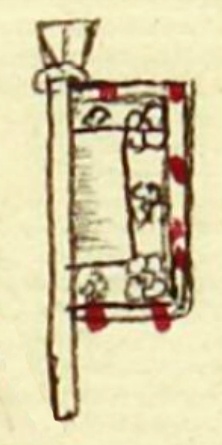Ayapan (MH535v)
This black-line drawing (with small spots of red paint) of the compound glyph for the personal name or place of origin, Ayapan (perhaps "Thin Cotton Flag," attested here as a man’s name), shows a flag (pamitl or panitl) flying out to the viewer's right. It is on a possibly wooden pole, and there is an adornment at the top of the pole. The flag has a border around three sides of the rectangle, seemingly with a flower design, and a white stripe with occasional red dots outside the flower design.
Stephanie Wood
Ayapan was a fairly common name. Four other glyphs for this personal name appear below. It could be a place of origin. A place named Ayapan exists in the state of Tabasco, Mexico (see: Daniel Suslak, “Ayapan Echoes,” American Anthropologist, Nov. 2011), and there may well be others. If Ayapan is not literally about a cotton flag, perhaps it refers to the medicinal plant, ayapana, so this could be the root of the name, and if so, the compound would be fully phonographic.
Stephanie Wood
1560
Jeff Haskett-Wood
fabrics, telas, textiles, flags, banners, banderas, flores, nombres de hombres

aya(tl), a thin cloak or blanket, https://nahuatl.wired-humanities.org/content/ayatl
pam(itl), flag, banner, https://nahuatl.wired-humanities.org/content/pamitl
Bandera de Ayate
Matrícula de Huexotzinco, folio 535v, https://www.loc.gov/resource/gdcwdl.wdl_15282/?sp=150&st=image
This manuscript is hosted by the Library of Congress and the World Digital Library; used here with the Creative Commons, “Attribution-NonCommercial-ShareAlike 3.0 License” (CC-BY-NC-SAq 3.0).









